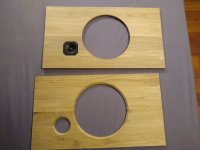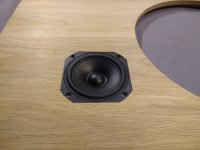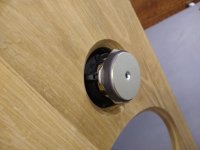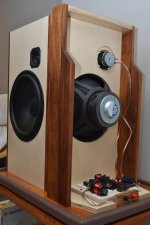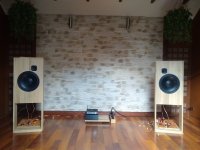It has to do with floor bounce and baffle loading. Of course when I built the first one after John's - I asked the same question "Can't I just make it a floor standing speaker?" But John had tried it and knows it sounds more balanced with the gap between baffle and floor.
John will be able to explain this better, but he's offline for a little while. I'm sure he will chime in when he gets back.
John will be able to explain this better, but he's offline for a little while. I'm sure he will chime in when he gets back.
Would be great if John give some background information.It has to do with floor bounce and baffle loading. Of course when I built the first one after John's - I asked the same question "Can't I just make it a floor standing speaker?" But John had tried it and knows it sounds more balanced with the gap between baffle and floor.
John will be able to explain this better, but he's offline for a little while. I'm sure he will chime in when he gets back.
I saw some designs where there was a slot / gap below or next to the woofer....maybe an openining of 1-2 inch is enough to make it sound right.
I was also thinking to move the full range to the middle, same distance to the woofer of course and open up one side next to the full range driver with same distance as the side to full range driver distance in the original design.
it's not a good idea ... if you want to copy the design, do it carefully and the result will be predictable 😃
Below is the result of today's work:
Below is the result of today's work:
Attachments
Why isnt it a good idea? The alterations will be made is such a way that they match the original.
LOL. The trouble with maintaining a thread like this is that so many people want to order "off the menu." 😉
The Manzanita design is very tolerant of changes and tweaks, but we do recommend building as designed in the thread.
Why? Because we know it will sound great. Creativity is encouraged, but for us it can be a bit much - all the "what if I did this, this and that?" questions.
The design here is presented as an easy way for you to get into Open Baffle goodness. The design has evolved over the years with careful consideration of price, driver availability, value for money and sound quality.
John and I recommend building the design as close as you can to specifications, even if you use cheap/scrap wood. It will give you an idea of what a well conceived OB should sound like. And perhaps you'll learn a trick or two while you build (some have been presented here in the thread.) Open Baffle is quick and inexpensive to build, so just go for it, tweak the crossover to your room and ears, then figure out if you want your own version.
The Manzanita design is very tolerant of changes and tweaks, but we do recommend building as designed in the thread.
Why? Because we know it will sound great. Creativity is encouraged, but for us it can be a bit much - all the "what if I did this, this and that?" questions.
The design here is presented as an easy way for you to get into Open Baffle goodness. The design has evolved over the years with careful consideration of price, driver availability, value for money and sound quality.
John and I recommend building the design as close as you can to specifications, even if you use cheap/scrap wood. It will give you an idea of what a well conceived OB should sound like. And perhaps you'll learn a trick or two while you build (some have been presented here in the thread.) Open Baffle is quick and inexpensive to build, so just go for it, tweak the crossover to your room and ears, then figure out if you want your own version.
Absolutely agree...but...
The fun of DIY is that you can make things the way you want it. You learn from commercial designs and other DIY designs trying to bring things together.
My questions are to the community not specific the designer. Of course the designers have a lot of knowledge and can give proper feedback. My questions are more related to the design I want (ascetic) related to the sound alteration they would bring. Maybe some have already experience in making a floorstanding baffle and took some measurements which can show the differences. Or know what influence a slot opening under the woofer will do.
So i dont need to reinvent the wheel here.
For me the outcome needs to be a floorstanding design. If it can not be closed then I need to think about a front cover grill.
The fun of DIY is that you can make things the way you want it. You learn from commercial designs and other DIY designs trying to bring things together.
My questions are to the community not specific the designer. Of course the designers have a lot of knowledge and can give proper feedback. My questions are more related to the design I want (ascetic) related to the sound alteration they would bring. Maybe some have already experience in making a floorstanding baffle and took some measurements which can show the differences. Or know what influence a slot opening under the woofer will do.
So i dont need to reinvent the wheel here.
For me the outcome needs to be a floorstanding design. If it can not be closed then I need to think about a front cover grill.
I'm starting tuning of the crossover...
The default value of R2 is 8ohm. Increasing to 12 or 15ohm decreases the amount of the highest tones? Hear it right?
When playing, I also feel that the top of the board is shaking quite a lot. Is gluing the upper beam between the sashes recommended? This will increase the path length of the sound wave emitted through the back of the VIFA. It's about the solution from the photo from another user.
The default value of R2 is 8ohm. Increasing to 12 or 15ohm decreases the amount of the highest tones? Hear it right?
When playing, I also feel that the top of the board is shaking quite a lot. Is gluing the upper beam between the sashes recommended? This will increase the path length of the sound wave emitted through the back of the VIFA. It's about the solution from the photo from another user.
Attachments
Last edited:
if it would effect the sound, you can always put a beam like in the picture you post but turn the beam 90degrees so that the big part stick to the back of the baffle.I'm starting tuning of the crossover...
The default value of R2 is 8ohm. Increasing to 12 or 15ohm decreases the amount of the highest tones? Hear it right?
When playing, I also feel that the top of the board is shaking quite a lot. Is gluing the upper beam between the sashes recommended? This will increase the path length of the sound wave emitted through the back of the VIFA. It's about the solution from the photo from another user.
I'm starting tuning of the crossover...
The default value of R2 is 8ohm. Increasing to 12 or 15ohm decreases the amount of the highest tones? Hear it right?
When playing, I also feel that the top of the board is shaking quite a lot. Is gluing the upper beam between the sashes recommended? This will increase the path length of the sound wave emitted through the back of the VIFA. It's about the solution from the photo from another user.
Your speakers are beautiful.
Give the drivers and components some time to settle in a bit before making crossover changes. It'll save some aggravation.
You can different us a top bar - and it will make the baffle and wings more rigid. Make it asymmetrical if you can to avoid cavity resonances. An overall taper or a bump in the middle is the typical way to do it. Perhaps large holes in the flat side, as is done in aircraft struts?
One way to describe the effect of continuing the baffle to the floor is this: baffles support the waves smaller than or close in size to the baffle.
If a baffle is continued to the floor all the waves longer than the original baffle size will be supported, so louder in front, except for
the dips created by the return from the front wall(shorter distance than to rear wall).
Not a problem when starting from scratch, but when starting from a previously balanced design, quite a bit of work may be required.
A grill is an elegant solution to the 'hole problem', as it allows you to have a proven design as reference, while letting you experiment
all you want. Kind of like putting a port on the rear of a BR, and stuffing or plugging it when you want.
If a baffle is continued to the floor all the waves longer than the original baffle size will be supported, so louder in front, except for
the dips created by the return from the front wall(shorter distance than to rear wall).
Not a problem when starting from scratch, but when starting from a previously balanced design, quite a bit of work may be required.
A grill is an elegant solution to the 'hole problem', as it allows you to have a proven design as reference, while letting you experiment
all you want. Kind of like putting a port on the rear of a BR, and stuffing or plugging it when you want.
Hmm, i made the ultra version, And it sounds pretty great. what would be the difference if i made the build with the smaller baffle?
- Home
- Loudspeakers
- Multi-Way
- Fast, fun, Inexpensive OB project
